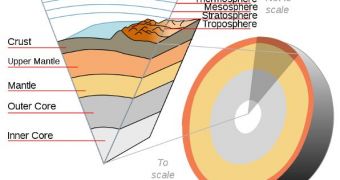Our planet is known to have a core, but not many people know that this central, molten region is also divided in two parts – the inner and outer cores. In a new scientific study, it was demonstrated that the outer core was indeed influenced by decade-long stirring motions, which kept it churning. This was hypothesized a long time ago, but clear evidence of this was never obtained before. The research also determined a number of common movement patterns associated with the outer core's motions.
The new data were combined by using those collected from land stations, ships at sea and satellites. The resulting work may give geologists and planetary scientists a better understanding of our planet's internal structure. It could also provide more details as to the processes that lead to the emergence and functioning of some basic terrestrial processes, including geology and magnetic-field formation. In addition, it was also confirmed again that the magnetic field around our planet protected us from harmful solar and cosmic radiation, allowing for life to thrive on our corner of the Universe.
Most people look at our planet and see it as a determined solid, part land, part water. But this simplistic view is far from the truth. There are a wide range of geological phenomena at work each second. Volcanoes erupt and create a new crust, while subduction zones gulp up pieces from the heaviest tectonic plates. Mountains rise, as they are rebounding from the now-gone weight of glaciers that pressed down on them thousands to millions of years ago. Landslides and glacier melts scar the terrain, do winds and water flows, and even entire continents can be sunken, or lifted, within years. Most of these events are directly related to the fact that, beneath the crust, the planet's core is molten and churning.
In the new work, it was also determined that a predictable series of periodic oscillations caused the molten metals and rocks that made up the inner part of the Earth to churn and stir up. Decades later, the motions become slower, only to be stirred up again later on. The investigation was conducted by expert Jean Dickey, who is based at the NASA Jet Propulsion Laboratory (JPL), in Pasadena, California. Also a part of the study was Institut de Physique du Globe de Paris expert Olivier deViron. The two authored, and coauthored, respectively, a new paper detailing the finds, which appears in the latest issue of the respected scientific journal Geophysical Research Letters.
“Although we do not observe the core directly, it's amazing how much we can learn about Earth's interior using magnetic field observations,” Dickey explains. “Our satellite-based results are in excellent agreement with the previous theoretical and other studies in this field, providing a strong confirmation of the existence of these oscillations. These results will give scientists confidence in using satellite measurements in the future to deduce long-term changes taking place deep within our restless planet,” she concludes.

 14 DAY TRIAL //
14 DAY TRIAL //